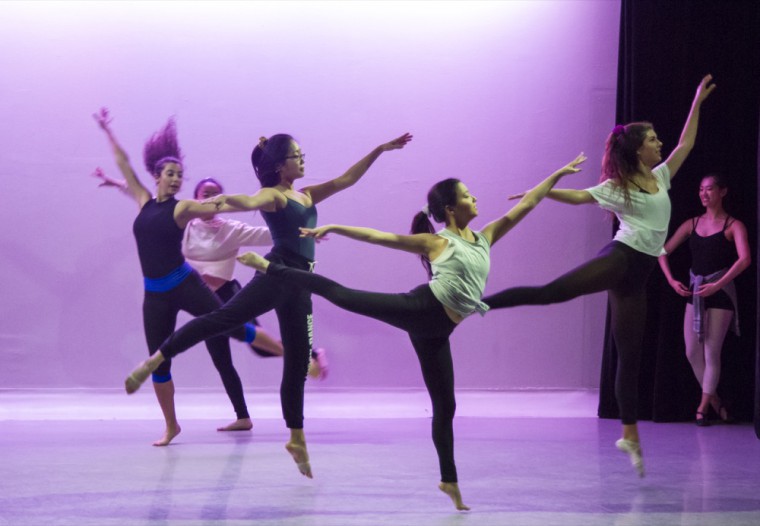Cadenza | Dance
Student Dance Showcase stages the variety of life
Students and faculty slowly filtered into the Mertz Studio in Mallinckrodt Saturday night for the annual Student Dance Showcase (SDS) annual performance. The spots on the floor mats filled up first, possibly because they were slightly cheaper or possibly because, in the paraphrased words of one attendee, that seating option makes it feel like a more intimate performance. No matter the reason, by the start of the show the mats had filled up and the seating behind them was mostly full as well.
 Isabella Neubauer | Student Life
Isabella Neubauer | Student Life Washington University students perform in the Student Dance Showcase in the Mertz Studio April 20. The Student Dance Showcase features original pieces by student dancers and choreographers.
The Student Dance Showcase is an opportunity for student dancers and choreographers to team up and produce something uniquely their own.
“Each choreographer can focus on whatever theme they would like, or they can choose to create a dance that is simply ‘dance for dance’s sake’ and not have a message at all! This is a chance for students to experiment with different styles of music and choreography as dancers and choreographers,” Lindsay Ragsdale and Maddie Noyes, co-directors of the Student Dance Showcase, wrote in a statement to Student Life.
To assist with that freedom of creative expression, the directors have very little involvement with auditions. Instead, the auditions function as an opportunity for the dancers and choreographers to choose each other.
“Based on the way the casting happens and the fact that a lot of the dancers only want to participate in one or two dances due to timing, it always works out that everyone who comes to auditions has a chance to be in the show, but this is not something we facilitate purposefully.
“We are so excited that SDS is an opportunity for everyone to dance, and we love that anyone who wants to participate is able to,” Ragsdale and Noyes wrote.
This also means that each individual piece does not necessarily have to fit into a cohesive theme for the entire show. That gives the choreographers and dancers much more freedom.
For their piece, Ragsdale and Noyes chose to use a musical theatre style.
“We wanted to do musical theatre because we thought it would give the show variety and would be a fun piece to choreograph,” Ragsdale and Noyes wrote. Their piece, “I Hope I Get It” from the Broadway musical “A Chorus Line” was the first of the show and set the tone for the night.
“There were moments of ballet, jazz, and contemporary-inspired movement,” Ragsdale and Noyes wrote. “We are so lucky that we had a group of dancers who were so willing to go for it with their characters and had so much fun with the dance.”
That spirit, a mashup of genres that was for lack of a better word, fun, was best showcased in “Cranes Improv,” choreographed and performed by freshman Ella Holman. Before starting her piece, Holman spoke about how in today’s world, people often expect something that follows strict guidelines. Her piece, which was improvised on the spot, was meant to break the audience out of that mindset and to introduce a sense of spontaneity to the show.
“We don’t know what we do know,” a piece choreographed by freshman Grace Myers also played on that abstract idea.
Myers said she would categorize her piece as “a post-modern concept piece,” though “the style that I did is much more of a concert dance style, and the piece is so much longer, and it was a lot more abstract than the other pieces.”
“When we went into the auditions, I told them they had two minutes to come up with three positions in their body that utilized triangles and negative space,” Myers explained, “and I gave them time to improv with that. … I decided to base my entire piece around [it].”
Somehow, despite the varied dance styles of all the performances, the whole show felt like more than the sum of its parts. Pieces such as “Supposed To Be,” choreographed by sophomore Aja Drain, and “Something Bad Feels Good,” choreographed by seniors Michelle Le and Emily Manin, played on each other in an interesting way. The first explored, as Drain notes in the playbill, “the difficulties of how a woman figures out who she is supposed to be,” while the second embraced a rebellious feminine identity.
The show finished with “swimmin’,” choreographed and performed by sophomore Avery Jones, and “Instrumentalism,” choreographed by freshman Grace Philion.
SDS jumped between many genres and tapped into a number of emotions. Sometimes the show was emphatic and assertive, and other times it was a confused search for meaning. Sometimes the stage was filled with dancers, and other times it had only one dancer. And yet somehow, the show never got lost in everything it tried to be. Instead, it embraced all of its parts, ending up, I think, exactly as it was meant to be: a celebration of individual creativity and the experience of life.
